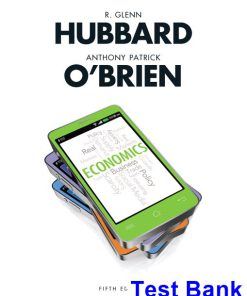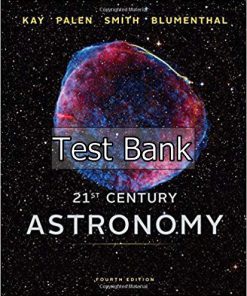$26.50$50.00 (-47%)
In stock
Economics 4th Edition Hubbard Test Bank.
You may also like
Economics 4th Edition Hubbard Test Bank

Product details:
- ISBN-10 : 013281725X
- ISBN-13 : 978-0132817257
- Author: R. Glenn Hubbard, Anthony P. O’Brien
Learn economics through real business examples.Hubbard/O’Brien explains the basics of economics by demonstrating how real businesses use economics to make real decisions everyday. This is something all readers can connect to, as they encounter businesses in their daily lives. And regardless of future career pathopening an art studio, doing social work, trading on Wall Street, working for the government, or bartending at the local pubreaders will benefit from understanding the economic forces behind their work.
Table contents:
Part 1 Introduction
1 Economics: Foundations and Models
Economics in Your Life and Career: How Much Will You Pay for a Cup of Coffee?
Three Key Economic Ideas
People Are Rational
People Respond to Incentives
Apply the Concept: Does Canada’s Health Care System Contribute to Obesity?
Optimal Decisions Are Made at the Margin
Solved Problem: 1.1 Binge Watching and Decisions at the Margin
The Economic Problems All Societies Must Solve
What Goods and Services Will Be Produced?
How Will the Goods and Services Be Produced?
Who Will Receive the Goods and Services Produced?
Centrally Planned Economies versus Market Economies
Apply the Concept: Central Planning Leads to Some Odd Products
The Modern Mixed Economy
Efficiency and Equity
Apply the Concept: The Equity–Efficiency Trade-off in the Classroom
Economic Models
The Role of Assumptions in Economic Models
Forming and Testing Hypotheses in Economic Models
Positive and Normative Analysis
Economics as a Social Science
Don’t Let This Happen to You: Don’t Confuse Positive Analysis with Normative Analysis
Apply the Concept: Should the Government of Saskatchewan Increase Its Minimum Wage?
Microeconomics and Macroeconomics
The Language of Economics
Economic in Your Life and Career: How Much Will You Pay for a Cup of Coffee?
Conclusion
Key Terms
Chapter Summary and Problems
Critical Thinking Exercises
Appendix: Using Graphs and Formulas
Graphs of One Variable
Graphs of Two Variables
Slopes of Lines
Taking into Account More than Two Variables on a Graph
Positive and Negative Relationships
Determining Cause and Effect
Are Graphs of Economic Relationships Always Straight Lines?
Slopes of Nonlinear Curves
Formulas
Formula for a Percentage Change
Formulas for the Areas of a Rectangle and a Triangle
Summary of Using Formulas
Problems and Applications
Economics in Your Life and Career: The Trade-offsWhen You Buy a Car
2 Trade-offs, Comparative Advantage,and the Market System
Production Possibilities Frontiers and Opportunity Costs
Graphing the Production Possibilities Frontier
Solved Problem: 2.1 Drawing a Production Possibilities Frontier for Pat’s Pizza Pit
Apply the Concept: Facing the Trade-offs of Health Care Spending
Increasing Marginal Opportunity Costs
Economic Growth
Comparative Advantage and Trade
Specialization and Gains from Trade
Absolute Advantage versus Comparative Advantage
Comparative Advantage and the Gains from Trade
Don’t Let This Happen to You: Don’t Confuse Absolute Advantage and Comparative Advantage
Solved Problem: 2.2 Comparative Advantage and the Gains from Trade
The Market System
The Circular Flow of Income
The Gains from Free Markets
The Legal Basis of a Successful Market System
Apply the Concept: Too Little of a Good Thing
Economics in Your Life and Career: The Trade-offs When You Buy a Car
Conclusion
Key Terms
Chapter Summary and Problems
Critical Thinking Exercises
3 Where Prices Come From: The Interaction of Supply and Demand
Economics in Your Life and Career: Can YOU Forecastthe Future Demand for Premium Bottled Water?
The Demand Side of the Market
Demand Schedules and Demand Curves
The Law of Demand
What Explains the Law of Demand?
That Magic Latin Phrase Ceteris Paribus
Variables that Shift Market Demand
Apply the Concept: The Transformation of Lobster from Inferior to Normal Good
Apply the Concept: Millennials Shake Up the Markets for Soda, Groceries, Big Macs, and Running Shoes
A Change in Demand versus a Changein Quantity Demanded
Apply the Concept: Forecasting the Demand for Premium Bottled Water
The Supply Side of the Market
Supply Schedules and Supply Curves
The Law of Supply
Variables that Shift Market Supply
A Change in Supply versus a Change in Quantity Supplied
Market Equilibrium: Putting Buyers and Sellers Together
How Markets Eliminate Surpluses and Shortages: Getting to Equilibrium
Solved Problem: 3.1 Demand and Supply Both Count: A Tale of Two Cards
Demand and Supply Both Count
The Effect of Demand and Supply Shifts on Equilibrium
The Effect of Shifts in Supply on Equilibrium
Solved Problem: 3.2 High Demand and Low Prices in the Lobster Market
Don’t Let This Happen to You: Remember: A Change in a Good’s Price Does Not Cause the Demand or
Shifts in a Curve versus Movements along a Curve
Economics in Your Life and Career: Can YOU Forecast the Future Demand for Premium Bottled Water?
Conclusion
Key Terms
Chapter Summary and Problems
Critical Thinking Exercises
Appendix: Quantitative Demand and Supply Analysis
Demand and Supply Equations
Problems and Applications
An Inside Look: Tim Hortons Launches Kids’ Menu in Push to Return to Its Roots
4 Economic Efficiency, Government Price Setting, and Taxes
Economics in Your Life and Career: Does Rent Control Make It Easier for You to Find an Affordable Ap
Consumer Surplus and Producer Surplus
Consumer Surplus
Apply the Concept: The Consumer Surplus from Uber
Producer Surplus
What Consumer Surplus and Producer Surplus Measure
The Efficiency of Competitive Markets
Marginal Benefit Equals Marginal Cost in Competitive Equilibrium
Economic Surplus
Deadweight Loss
Economic Surplus and Economic Efficiency
Government Intervention in the Market: Price Floors and Price Ceilings
Price Floors: Government Policy in Agricultural Markets
Apply the Concept: Price Floors in Labour Markets: The Debate over Minimum Wage Policy
Price Ceilings: Government Rent Control Policy in Housing Markets
Black Markets
Don’t Let This Happen to You: Don’t Confuse “Scarcity” with “Shortage”
Solved Problem: 4.1 What’s the Economic Effect of a Black Market for Apartments?
The Results of Government Price Controls: Winners, Losers, and Inefficiency
Apply the Concept: Price Controls and the Venezuelan Economy
Positive and Normative Analysis of Price Ceilings and Price Floors
The Economic Impact of Taxes
The Effect of Taxes on Economic Efficiency
Tax Incidence: Who Actually Pays a Tax?
Solved Problem: 4.2 When Do Consumers Pay All of a Sales Tax Increase?
Apply the Concept: How Is the Burden of Employment Insurance Premiums Shared between Workers and Fir
Economics in Your Life and Career: Does Rent Control Make It Easier for You to Find an Affordable Ap
Conclusion
Key Terms
Chapter Summary and Problems
Critical Thinking Exercises
An Inside Look: As Canadians buy record numberof pickups and SUVs, new fuel-economy rulesmay prove h
Part 2 Markets in Action: Policy and Applications
5 Externalities, Environmental Policy, and Public Goods
Economics in Your Life and Career: What’s the “Best” Level of Pollution?
Externalities and Economic Efficiency
The Effect of Externalities
Externalities and Market Failure
What Causes Externalities?
Private Solutions to Externalities: The Coase Theorem
The Economically Efficient Level of Pollution Reduction
Apply the Concept: The Montreal Protocol: Reducing Your Chances of Getting Skin Cancer
The Basis for Private Solutions to Externalities
Don’t Let This Happen to You: Remember That It’s the Net Benefit That Counts
Apply the Concept: The Fable of the Bees
Do Property Rights Matter?
The Problem of Transactions Costs
The Coase Theorem
Government Policies to Deal with Externalities
Solved Problem: 5.1 Using a Tax to Deal with a Negative Externality
Apply the Concept: Taxation and the Battle of the Bulge
Command-and-Control versus Market-Based Approaches
Are Tradable Emissions Allowances Licences to Pollute?
Apply the Concept: Can a Cap-and-Trade System Reduce Global Warming?
Four Categories of Goods
The Demand for a Public Good
The Optimal Quantity of a Public Good
Common Resources
Solved Problem: 5.2 Determining the Optimal Level of Public Goods
Economics in Your Life and Career: What’s the “Best” Level of Pollution?
Conclusion
Key Terms
Chapter Summary and Problems
Critical Thinking Exercises
6 Elasticity: The Responsiveness of Demand and Supply
Economics in Your Life and Career: Would PepsiCo and One of Its Bottlers Prefer a National or a Loca
The Price Elasticity of Demand and Its Measurement
Measuring the Price Elasticity of Demand
Apply the Concept: Elastic Demand and Inelastic Demand
An Example of Calculating Price Elasticities
The Midpoint Formula
Solved Problem: 6.1 Calculating the Price Elasticity of Demand
When Demand Curves Intersect, the Flatter Curve Is More Elastic
Polar Cases of Perfectly Elastic and Perfectly Inelastic Demand
Don’t Let This Happen to You: Don’t Confuse Inelastic with Perfectly Inelastic
The Determinants of the Price Elasticity of Demand
Availability of Close Substitutes
Passage of Time
Luxuries versus Necessities
Definition of the Market
Share of a Good in a Consumer’s Budget
Some Estimated Price Elasticities of Demand
The Relationship between Price Elasticity of Demand and Total Revenue
Elasticity and Revenue with a Linear Demand Curve
Solved Problem: 6.2 Price and Revenue Don’t Always Move in the Same Direction
Apply the Concept: Why Does Amazon Care about Price Elasticity?
Other Demand Elasticities
Cross-Price Elasticity of Demand
Income Elasticity of Demand
Using Elasticity to Analyze the Disappearing Family Farm
Apply the Concept: Price Elasticity, Cross-Price Elasticity, and Income Elasticity in the Market for
Solved Problem: 6.3 Using Price Elasticity to Analyze the Effects of a Soft Drink Tax
The Price Elasticity of Supply and Its Measurement
Measuring the Price Elasticity of Supply
Determinants of the Price Elasticity of Supply
Apply the Concept: Why Are Oil Prices So Unstable?
Polar Cases of Perfectly Elastic and Perfectly Inelastic Supply
Using Price Elasticity of Supply to Predict Changes in Price
Economics in Your Life and Career: Would PepsiCo and One of Its Bottlers Prefer a National or a Loca
Conclusion
Key Terms
Chapter Summary and Problems
Critical Thinking Exercises
An Inside Look: The best is the enemy of the green
Part 3 Firms in the Domestic and International Economies
7 Comparative Advantage and the Gains from International Trade
Economics in Your Life and Career: Should Your Member of Parliament Support a Tariff on Running Shoe
Canada and the International Economy
The Importance of Trade to the Canadian Economy
Canadian International Trade in a World Context
Comparative Advantage in International Trade
A Brief Review of Comparative Advantage
Comparative Advantage in International Trade
How Countries Gain from International Trade
Increasing Consumption through Trade
Apply the Concept: Bombardier Depends on International Trade
Why Don’t We Observe Complete Specialization?
Does Anyone Lose as a Result of International Trade?
Don’t Let This Happen to You: Remember That Trade Creates BOTH Winners and Losers
Where Does Comparative Advantage Come From?
Comparative Advantage over Time: The Rise and Fall of North American Manufacturing
Government Policies That Restrict International Trade
The Benefits of Trade—Imports
The Gains from Trade—Exports
Apply the Concept: USMCA—A New and Improved NAFTA?
Solved Problem: 7.1 Measuring the Effect of a Quota
The High Cost of Preserving Jobs with Tariffs and Quotas
Gains from Unilateral Elimination of Tariffs and Quotas
Other Barriers to Trade
The Arguments over Trade Policies and Globalization
Why Do Some People Oppose the World Trade Organization?
Apply the Concept: The Unintended Consequences of Banning Goods Made with Child Labour
Positive versus Normative Analysis (Once Again)
Economics in Your Life and Career: Should Your Member of Parliament Support a Tariff on Running Shoe
Conclusion
Key Terms
Chapter Summary and Problems
Critical Thinking Exercises
An Inside Look: Trump’s Washing Machine Tariffs Stung Consumers While Lifting Corporate Profits
Part 4 Microeconomic Foundations: Consumers and Firms
8 Consumer Choice and Behavioural Economics
Economics in Your Life and Career: Do You Make Rational Decisions?
Utility and Consumer Decision Making
The Economic Model of Consumer Behaviour in a Nutshell
Utility
The Principle of Diminishing Marginal Utility
The Rule of Equal Marginal Utility per Dollar Spent
Solved Problem: 8.1 Finding the Optimal Level of Consumption
What If the Rule of Equal Marginal Utility per Dollar Does Not Hold?
The Income Effect and Substitution Effect of a Price Change
Where Demand Curves Come From
Apply the Concept: Are There Any Upward-Sloping Demand Curves in the Real World?
Social Influences on Decision Making
The Effects of Celebrity Endorsements
Apply the Concept: Why Do Firms Pay Connor McDavid to Endorse Their Products?
Network Externalities
Does Fairness Matter?
Apply the Concept: Who Made the Most Profit from the Broadway Musical Hamilton?
Behavioural Economics: Do People Make Their Choices Rationally?
Ignoring Nonmonetary Opportunity Costs
Failing to Ignore Sunk Costs
Apply the Concept: A Blogger Who Understands the Importance of Ignoring Sunk Costs
Being Unrealistic about Future Behaviour
Apply the Concept: Why Don’t Students Study More?
Solved Problem: 8.2 How Do You Get People to Save More of Their Income?
“Nudges”: Using Behavioural Economics to Guide Behaviour
The Behavioural Economics of Shopping
Economics in Your Life and Career: Do You Make Rational Decisions?
Conclusion
Key Terms
Chapter Summary and Problems
Critical Thinking Exercises
An Inside Look: One Simple Rule: Why Teens Are Fleeing Facebook
Part 5 Market Structure and Firm Strategy
9 Technology, Production, and Costs
Economics in Your Life and Career: Using Cost Concepts in Your Own Business
Technology: An Economic Definition
Apply the Concept: Would You Please Be Quiet? Technological Change at Segment.com
The Short Run and the Long Run in Economics
The Difference between Fixed Costs and Variable Costs
Apply the Concept: Fixed Costs in the Publishing Industry
Implicit Costs versus Explicit Costs
The Production Function
A First Look at the Relationship between Production and Cost
The Marginal Product of Labour and the Average Product of Labour
The Law of Diminishing Returns
Graphing Production
Apply the Concept: Adam Smith’s Famous Account of the Division of Labour in a Pin Factory
The Relationship between Marginal Product and Average Product
An Example of Marginal and Average Values: University Grades
The Relationship between Short-Run Production and Short-Run Cost
Marginal Cost
Why Are the Marginal and Average Cost Curves U Shaped?
Solved Problem: 9.1 Calculating Marginal Cost and Average Cost
Graphing Cost Curves
Costs in the Long Run
Economies of Scale
Long-Run Average Cost Curves for Automobile Factories
Solved Problem: 9.2 Using Long-Run Average Cost Curves to Understand Business Strategy
Apply the Concept: The Colossal River Rouge: Diseconomies of Scale at Ford Motor Company
Don’t Let This Happen to You: Don’t Confuse Diminishing Returns with Diseconomies of Scale
Economics in Your Life and Career: Using Cost Concepts in Your Own Business
Conclusion
Key Terms
Chapter Summary and Problems
Critical Thinking Exercises
Appendix: Using Isoquants and Isocost Lines to Understand Production and Cost
Isoquants
An Isoquant Graph
The Slope of an Isoquant
Isocost Lines
Graphing the Isocost Line
The Slope and Position of the Isocost Line
Choosing the Cost-Minimizing Combination of Capital and Labour
Different Input Price Ratios Lead to Different Input Choices
Another Look at Cost Minimization
Solved Problem 9A.1: Firms Responding to Differences in Input Price Ratios
Solved Problem 9A.2: Determining the Optimal Combination of Inputs
Apply the Concept: Do National Football League Teams Behave Efficiently?
The Expansion Path
Key Terms
10 Firms in Perfectly Competitive Markets
Economics in Your Life and Career: Are You an Entrepreneur?
Perfectly Competitive Markets
A Perfectly Competitive Firm Cannot Affect the Market Price
The Demand Curve for the Output of a Perfectly Competitive Firm
Don’t Let This Happen to You: Don’t Confuse the Demand Curve for Farmer Parker’s Wheat with th
How a Firm Maximizes Profit in a Perfectly Competitive Market
Revenue for a Firm in a Perfectly Competitive Market
Determining the Profit-Maximizing Level of Output
Illustrating Profit or Loss on the Cost Curve Graph
Showing Profit on a Graph
Solved Problem: 10.1 Determining Profit-Maximizing Price and Quantity
Don’t Let This Happen to You: Remember that Firms Maximize Their Total Profit, Not Their Profit pe
Illustrating When a Firm Is Breaking Even or Operating at a Loss
Apply the Concept: Losing Money in the Restaurant Business
Deciding Whether to Produce or to Shut Down in the Short Run
The Supply Curve of a Firm in the Short Run
Solved Problem: 10.2 When to Shut Down a Farm
The Market Supply Curve in a Perfectly Competitive Industry
“If Everyone Can Do It, You Can’t Make Money at It”: The Entry and Exit of Firms in the Long R
Economic Profit and the Entry or Exit Decision
Long-Run Equilibrium in a Perfectly Competitive Market
The Long-Run Supply Curve in a Perfectly Competitive Market
Increasing-Cost and Decreasing-Cost Industries
Apply the Concept: In the Apple App Store, Easy Entry Makes the Long Run Pretty Short
Perfect Competition and Economic Efficiency
Productive Efficiency
Solved Problem: 10.3 How Productive Efficiency Benefits Consumers
Allocative Efficiency
Economics in Your Life and Career: Are You an Entrepreneur?
Conclusion
Key Terms
Chapter Summary and Problems
Critical Thinking Exercises
11 Monopolistic Competition: The Competitive Model in a More Realistic Setting
Economics in Your Life and Career: Can You Operate a Successful Restaurant?
Demand and Marginal Revenue for a Firm in a Monopolistically Competitive Market
The Demand Curve for a Monopolistically Competitive Firm
Marginal Revenue for a Firm with a Downward-Sloping Demand Curve
How a Monopolistically Competitive Firm Maximizes Profit in the Short Run
Solved Problem: 11.1 Does Minimizing Cost Maximize Profit at Apple?
What Happens to Profits in the Long Run?
How Does the Entry of New Firms Affect the Profits of Existing Firms?
Don’t Let This Happen to You: Don’t Confuse Zero Economic Profit with Zero Accounting Profit
Apply the Concept: Is “Clean Food” a Sustainable Market Niche for Panera?
Is Zero Economic Profit Inevitable in the Long Run?
Solved Problem: 11.2 Red Robin Abandons an Experiment in Fast-Casual Restaurants
Comparing Monopolistic Competition and Perfect Competition
Excess Capacity under Monopolistic Competition
Is Monopolistic Competition Inefficient?
How Consumers Benefit from Monopolistic Competition
Apply the Concept: One Way to Differentiate Your Restaurant? Become a Ghost!
How Marketing Differentiates Products
Brand Management
Advertising
Defending a Brand Name
What Makes a Firm Successful?
Apply the Concept: Is Being the First Firm in the Market a Key to Success?
Economics in Your Life and Career: Opening Your Own Restaurant
Conclusion
Key Terms
Chapter Summary and Problems
Critical Thinking Exercises
12 Oligopoly: Firms in Less Competitive Markets
Economics in Your Life and Career: If You Were Managing a Walmart, Would You Cut the Price of a Play
Oligopoly and Barriers to Entry
Barriers to Entry
Apply the Concept: Got a Great Recipe for Cookies? Don’t Try Selling Them Anywhere Other Than Farm
Game Theory and Oligopoly
A Duopoly Game: Price Competition between Two Firms
Firm Behavior and the Prisoner’s Dilemma
Can Firms Escape the Prisoner’s Dilemma?
Don’t Let This Happen to You: Don’t Misunderstand Why Each Firm Ends Up Charging a Price of $9.9
Solved Problem: 12.1 Is Offering a University Student Discount a Prisoner’s Dilemma for Apple and
Apply the Concept: Are Airlines in North America Colluding?
Cartels: The Case of OPEC
Sequential Games and Business Strategy
Deterring Entry
Solved Problem: 12.2 Is Deterring Entry Always a Good Idea?
Bargaining
The Five Competitive Forces Model
1. Competition from Existing Firms
2. The Threat from Potential Entrants
3. Competition from Substitute Goods or Services
4. The Bargaining Power of Buyers
5. The Bargaining Power of Suppliers
Apply the Concept: Can We Predict Which Firms Will Continue to Be Successful?
Economics in Your Life & Career: If You Were Managing a Walmart, Would You Cut the Price of a PlaySt
Conclusion
Key Terms
Chapter Summary and Problems
Critical Thinking Exercises
13 Monopoly and Competition Policy
Economics in Your Life and Career: Why Does Toronto Have Only One NHL Team?
Is Any Firm Ever Really a Monopoly?
Apply the Concept: Netflix Not So Chill
Where Do Monopolies Come From?
Government Action Blocks Entry
Apply the Concept: A Monopoly® Monopoly
Control of a Key Resource
Apply the Concept: Are Diamond Profits Forever? The De Beers Diamond Monopoly
Network Externalities
Natural Monopoly
Solved Problem: 13.1 Is Facebook a Natural Monopoly?
How Does a Monopoly Choose Price and Output?
Marginal Revenue Once Again
Profit Maximization for a Monopolist
Solved Problem: 13.2 Finding the Profit-Maximizing Price and Output for a Monopolist
Don’t Let This Happen to You: Don’t Assume that Charging a Higher Price Is Always More Profitabl
Does Monopoly Reduce Economic Efficiency?
Comparing Monopoly and Perfect Competition
Measuring the Efficiency Losses from Monopoly
How Large Are the Efficiency Losses Due to Monopoly?
Market Power and Technological Change
Government Policy toward Monopoly
Competition Laws and Enforcement
Mergers: The Trade-off between Market Power and Efficiency
The Competition Bureau and Merger Guidelines
Regulating Natural Monopolies
Solved Problem: 13.3 What Should Your University Charge for a MOOC?
Economics in Your Life and Career: Why Does Toronto Have Only One NHL Team?
Conclusion
Key Terms
Chapter Summary and Problems
Critical Thinking Exercises
An Inside Look: Canada’s oil sands: The steam from below
Part 6 Labour Markets, Public Choice, and the Distribution of Income
14 The Markets for Labour and Other Factors of Production
Economics in Your Life and Career: When Should You Give an Employee a Raise?
The Demand for Labour
The Marginal Revenue Product of Labour
Solved Problem: 14.1 Hiring Decisions by a Firm that Is a Price Maker
The Market Demand Curve for Labour
Factors That Shift the Market Demand Curve for Labour
The Supply of Labour
The Market Supply Curve of Labour
Factors that Shift the Market Supply Curve of Labour
Equilibrium in the Labour Market
The Effect on Equilibrium Wages of a Shift in Labour Demand
The Effect of Immigration on the Canadian Labour Market
Apply the Concept: Is Investing in a University Education a Good Idea?
Apply the Concept: Will You Compete with a Robot for a Job—Or Work with One?
Explaining Differences in Wages
Compensating Differentials
Don’t Let This Happen to You: Remember that Prices and Wages Are Determined at the Margin
Apply the Concept: Technology and the Earnings of “Superstars”
Discrimination
Solved Problem: 14.2 Is Passing “Comparable Worth” Legislation a Good Way to Close the Gap betwe
Apply the Concept: Does Greg Have an Easier Time Finding a Job than Jamal?
Labour Unions
Personnel Economics
Should Workers’ Pay Depend on How Much They Work or on How Much They Produce?
Apply the Concept: A Better Way to Sell Contact Lenses
Other Considerations in Setting Compensation Systems
The Markets for Capital and Natural Resources
The Market for Capital
The Market for Natural Resources
Monopsony
The Marginal Productivity Theory of Income Distribution
Economics in Your Life and Career: When Should You Give an Employee a Raise?
Conclusion
Key Terms
Chapter Summary and Problems
Critical Thinking Exercises
15 Public Choice, Taxes, and the Distribution of Income
Economics in Your Life and Career: How Much Tax Should You Pay?
Public Choice
How Do We Know the Public Interest? Models of Voting
Government Failure?
Is Government Regulation Necessary?
The Tax System
An Overview of the Canadian Tax System
Progressive and Regressive Taxes
Marginal and Average Income Tax Rates
Apply the Concept: Which Groups Pay the Most in Federal Taxes?
International Comparison of Corporate Income Taxes
Evaluating Taxes
Apply the Concept: Should the Federal Government Raise Income Taxes or the GST?
Tax Incidence Revisited: The Effect of Price Elasticity
Don’t Let This Happen to You: Remember Not to Confuse Who Pays a Tax with Who Bears the Burden of
Apply the Concept: Do Corporations Really Bear the Burden of the Federal Corporate Income Tax?
Solved Problem: 15.1 The Effect of Price Elasticity on the Excess Burden of a Tax
Income Distribution and Poverty
Measuring the Income Distribution and Poverty
Factors Related to Poverty and Income Inequality
Showing the Income Distribution with a Lorenz Curve
Problems in Measuring Poverty and the Distribution of Income
Solved Problem: 15.2 Are Many Individuals Stuck in Poverty?
Income Distribution and Poverty around the World
Economics in Your Life and Career: How Much Tax Should You Pay?
Conclusion
Key Terms
Chapter Summary and Problems
Critical Thinking Exercises
An Inside Look: Why Are Harvard Graduatesin the Mailroom?
Glossary
Company Index
Subject Index
People also search;
economics 4th edition hubbard
economics hubbard 8th edition
hubbard and o’brien economics 8th edition
glenn hubbard economics
k hubbard and associates












